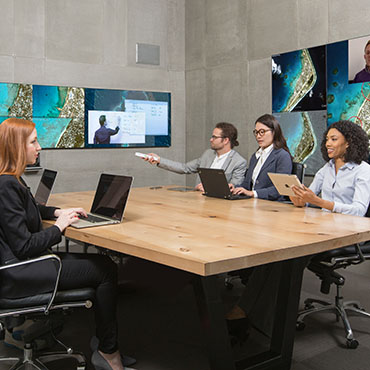More screens, more millennials?

Getting young people into government can be challenging. One company's prescription: Wow them with a "Minority Report" conference room.

(Mezzanine / Oblong)
Millennials already work, date and sleep surrounded by glowing screens. Now one company says a few more screens could be the key to getting millennials to stay in the federal workforce.
Oblong Industries’ six-screen, wand-directed setup called Mezzanine is based on the futuristic technology that CEO John Underkoffler created for the movie “Minority Report.”
“You really have to see it to understand,” said Michael Friedel, the company’s federal director.
It’s more than a videoconferencing tool, he added. It’s part of a bigger “office of the future” movement that will help workers collaborate in meaningful ways.
A typical Mezzanine room has six screens, a few dozen motion sensors installed on the ceiling and a Dell server.
Three of the screens display a variety of content: colleagues calling in from other locations, prepared slides and, most interesting, the data from apps running on connected devices. Mezzanine is about as agnostic as it can be, and basically any tablet, smartphone or laptop anyone brings into a room can be shared on screen with the whole team.
The other three screens function as “cork boards.” Users can take snapshots on the main screens, then whip them over to the cork boards to be rearranged, analyzed and saved.
The finished product is part Wii, part Skype, part detective show thumbtacks-and-string.
Mezzanine is sold as an appliance, not as an enterprise service. “The ability to get this data visibility with zero integration services [is] huge,” Friedel said.
He also said Mezzanine and other office-transforming tools could provide the “wow” factor the government needs to attract young techies.
“The government is so regulated and policy-bound, things always seem like they’re generations behind,” Friedel said. “When it comes to recruiting and retaining people and talent, you’ve got to have some modern tools for them.”
One of the Navy’s commands recently purchased Mezzanine rooms, and he recalled the commander saying, “‘We have a heck of a time getting people to come to [rural America] to work for the Navy, and if they’re there, we have a tough time keeping them because we’re just laden in these old processes and stovepiped systems.’”
Friedel added that the commander “saw the ability to be able to offer modernized tools that would actually attract younger people to come into the service.”
Jennifer Üner, Oblong’s communications director, said her favorite quote came from Ian Rogers before he sold Beats Music to Apple: "When someone comes to your office to learn your vision of the future, it's crucial they feel like they've walked into the future, not the past."
“It would be nice to think that it was because he brought the Apple executives into his Mezzanine conference room that he sold his company for $3 billion,” Üner said. “But I’m sure there were some other contributing factors.”
There are other barriers to attracting and keeping millennials in government jobs -- for instance, the management culture and cumbersome hiring procedures -- but for Friedel, technology is the main one.
Millennials carry reams of data in their pockets, he said, and they expect to be able to share that data seamlessly.
“As you see more and more young people come into the government ranks, let’s face it, there isn’t [anybody who’s] not walking around with these things,” he said, brandishing an iPhone. “They expect tools to be at their fingertips, and they expect it to be easy to do this stuff.”
NEXT STORY: Brubaker joins IT Cadre


